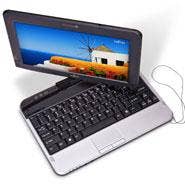Fujitsu Still Has The Touch With LifeBooks
With the release of no fewer than five high-end mobile computers at CES earlier this month -- including a 3D unit, a Core i7 ultraportable and two tablet convertibles -- Fujitsu demonstrates that it will continue to innovate for niche market segments.

Case in point: The LifeBook T580 Tablet PC, which Fujitsu sent the CRN Test Center for review. This well-equipped three pounder is built around an Intel Core i5 (model U560) processor 1.33 GHz and was running Windows 7 Professional 32-bit on 2GB of memory. It incorporates a 10.1-inch, four-point touch sensitive screen and N-Trig capacitive pen system and controller software. You don't have to be a digital artist to appreciate the capabilities that this tablet provides, particularly for 2D content creators.
With the display set at its native resolution of 1366 x 768 pixels, testers had a hard time navigating around Windows with a finger, and found reading text on menus and dialog boxes to be a strain. Switching to "Touch Mode" in the LifeBook's Launcher menu corrected this problem, growing the font size in active applications, and a few changes to Windows' default screen settings were still necessary for desktop items. Navigation was made easier when using the active stylus, which is far more precise than our stubby fingers.
But the real magic happens when launching your favorite graphics creation package. The so-called digital pencil (which takes a quadruple-A battery, included), functions much like any stylus, but adds 256 levels of pressure sensitivity and a hovering feature that causes the cursor to follow the tool's tip without touching the glass. It's also smart enough to know the difference between the tool and the artist's palm or other part of the hand, which often lays on the glass while drawing. At the same time, the digitizer also is capable of recognizing the touch of as many as four finger tips.
Testers also liked using the stylus for writing, and found that the handwriting recognition software worked pretty well. The system also worked well with Evernote, the free note taking app.
For some, this form of input might be easier than the cramped keyboard on most netbooks, but the T580's is only an inch narrower than the keyboard of a full-sized laptop, and felt pretty comfortable to type on. It's also spill resistant. The trackpad is quite small at 2.25-inches across by 1.25 up and down; far too small to be used for long periods.
Next: Putting The Tablet Through Its Paces Since there's no optical drive on the t580, our normal battery test procedure was impossible. With all power saving features disabled, we played a video movie from a USB stick until the battery went from fully charged to powering down the machine. That time was exactly one hour and 16 minutes, which is not very good.
However, we estimate that with Windows power saving features enabled plus a few device-specific controls added by Fujitsu, we estimate that battery life should be about double that of our tests.
When used as a tablet, the screen lays flat and meshes nicely with the raised portion of the case that is home to the swivel and control buttons for screen rotation, menu and log-off/shutdown. Screen rotation is not perfect; often rendering upside down when going from landscape to portrait. But for that we blame Windows. Fujitsu could improve situation by employing an accelerometer to automate screen rotation as the iPad and other Apple devices. Unlike the current iPad, the T580 has a camera, albeit a 1.3 megapixel model; there's also a fingerprint reader.
Unlike its predecessors, the Lifebook T580 doesn't suffer from an abundance of thermal output. The hottest spot was the exhaust port, which put out a steady 90-degree breeze on the unit's left edge. The only accessory included with our review unit was a cleaning cloth for the screen. Fujitsu offers numerous others to make tablet use easier, including a bottom-mounted hand strap, a carry strap and padded case. Hard drive options are available up to 500 GB mechanical and 128-GB SSD, and all are shock-mounted and protected with Fujitsu's shock detection software.
Try as it might, Windows 7 is simply not a tablet operating system. Pinch-to-zoom is nice, but a truly usable tablet interface includes features swoop and two-finger scroll, and incorporates mouse and/or trackpad functions that can work in conjunction with modifier keys. Application and operating system performance was responsive, despite a less than stellar Geekbench score of 3017. The best Core i5 score we've seen first hand was that of the Panasonic ToughBook at 4596.
Despite table-unfriendly obstacles of its operating system, Fujitsu has delivered a friendly user experience on this well-equipped LifeBook T580 Tablet PC. For professional artists and other content creators, or for specialized applications in health-care and other touch-input verticals, the Fujitsu Lifebook T580 would be a solid choice and is a recommended product. Pricing starts at $1,149 ($1,399 as tested).